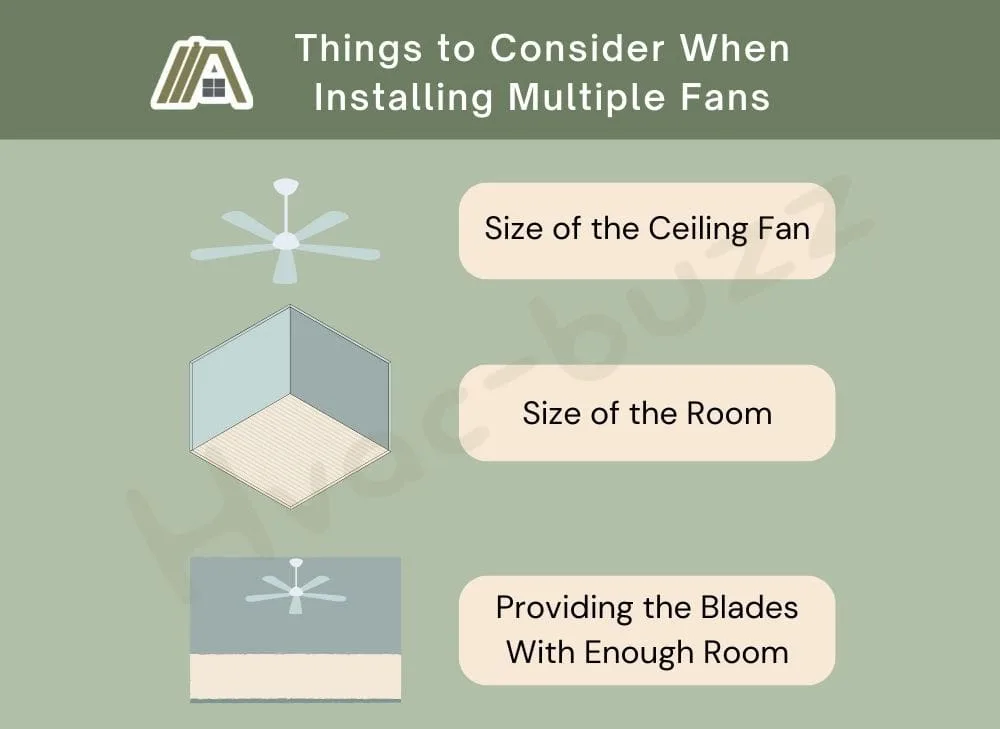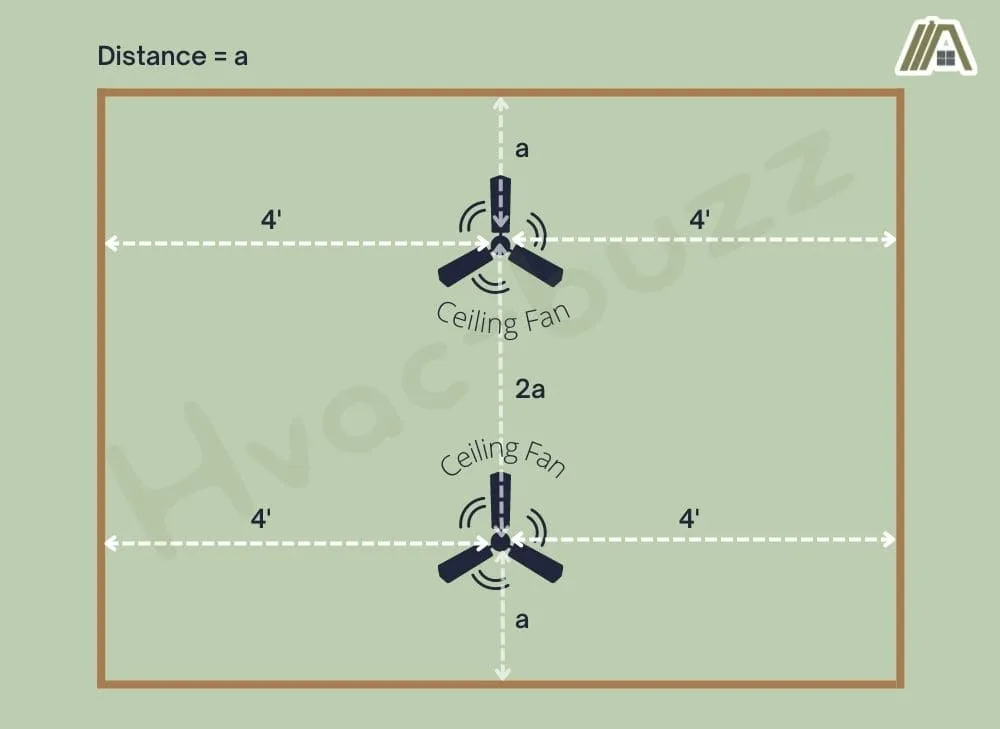If your ceiling fan is not doing its job, this may not be related to its quality, but rather its effectiveness in a larger space. A large, long, or high-ceiling room can pose problems for a single fan because the area receiving the most airflow from the fan is the area directly beneath it.
The size of the ceiling fan, as well as the room, can factor into how effective a fan will be, but sometimes, you have to install multiple ceiling fans to really make a difference. Recommended clearances and layouts for multiple ceiling fans should be followed for improved performance.

For multiple ceiling fans, they should be installed with at least 18" between the blades. Ideally, the space between the fans should be double the distance that each fan is from the wall that is closest to it.
| Fan Size | Minimum distance between the two fans* |
| 36” | 54” |
| 42” | 60” |
| 44” | 62” |
| 48” | 66” |
| 52” | 70” |
| 54” | 72” |
| 56” | 74” |
| 60” | 78” |
| 72” | 90” |
Do You Need More Than One Ceiling Fan per Room?
It is usually only necessary to have more than one ceiling fan if the room in question is much larger than average rooms. Most fans have an estimated square footage for which they can provide ample airflow.
Once a room exceeds a fan’s suggested square footage, it may be necessary to get a more powerful fan or to purchase a second fan, depending on how much the ideal square footage is exceeded, and taking into consideration that bigger blades are not always better.
Another room that may require more than one ceiling fan is a long room or hall. This is because ceiling fans are made to produce airflow from a central place in the room.

Even if the hall matches the recommended airflow area for the fan, the length means that most of the space is not benefiting properly from the fan’s airflow. The furthest areas are harder to reach and just one fan may struggle to reach the far expanses.
High ceilings can also pose a problem for singular fans. With a ceiling fan further from the floor, its airflow is less likely to reach the occupied areas of the room. Another ceiling fan may be necessary to achieve the required airflow.
Alternative Option: Installing a Dual Ceiling Fan
Instead of installing more than one fan, a dual ceiling fan might be the right fit for you.
A dual ceiling fan is a singular fixture with two ceiling fan heads.
- 【Double ceilingfan】:Double-headed fan,the wind is super strong,bring more wind to the space. Dual ceiling fan can be positioned in 90°arcs for optimum airflow.
- 【Angle Ceiling Fan】:The Double Ceiling Fan can installed on a ceiling with maximum slope of 15 degree. And the angle of the fan head can be adjusted manually (0-90 degrees).
- 【Dimmable Ceiling Fan】:LED dimmer You can adjust the brightness and it had 3color Temperature Switch can change for Warm/warm white/white LED color.
- 【Fan control】:Dual ceiling fan with light 3-speed fan and light remoteLED dimmer and supporting timing(2/4/8 hours) sleep off.The fan or lighting device can be turned on separately.
Last update on 2024-03-27 / Affiliate links / Images from Amazon Product Advertising API
They can oscillate and rotate to ensure that air circulates through the entire space.
One benefit of using a dual ceiling fan rather than multiple fans is that it only requires a single installation. This can save time as well as frustration.
Because of their highly-effective air circulation, they are ideal for large rooms, whereas multiple ceiling fans are usually ideal for long hallways and rooms.

Things to Consider When Installing Multiple Fans
Size of the Ceiling Fan
Although installing another ceiling fan or a dual ceiling fan would certainly create more airflow in a larger, longer, or high ceiling room, it is possible that this problem can be solved with a differently-sized ceiling fan.
Although the volume of airflow depends solely on the motor of the ceiling fan, the length of the blades controls how the airflow is distributed and how direct it is.
Longer ceiling fan blades are ideal for large rooms since the greater surface area of the blades means that the airflow will be more spread out. This means that a greater area of the room will be impacted by this airflow but the airflow is softer and not as direct because of this.
Shorter ceiling fan blades are ideal for smaller rooms or situations where you want direct, intense airflow. Because shorter ceiling fan blades have a smaller surface area, the airflow is not distributed as widely. This means that the airflow is more direct, intense, and confined to a smaller area.
Size of the Room
As I mentioned before, each ceiling fan has a room area that is best suited for the airflow they produce.
Before you decide whether you should install another ceiling fan or a dual ceiling fan, it is important to consider the possibility that a fan type more suited for your room may be out there.
In order to determine what fan would be best for your room, precise measurements must be taken to get the square footage.
To do this, you’ll need a tape measure and possibly a partner to hold the other end so that you can get the most accurate measurements possible.
Measure the length and then the width of the room and multiply them together to get the area of the room in square footage, or whatever units you’d like to use.
Once the area of the room is known, you can research on whatever fan website you’d like.
Most will have ranges of square footage that you can select. Each fan should also have a recommended square footage available in its description.
Providing the Blades With Enough Room
Although giving ceiling fan blades enough room to move ensures that they won’t hit walls, furniture, or people, proper clearance also ensures that the ceiling fan’s airflow is improved.
If your ceiling fan isn’t operating at its best, the problem may be insufficient clearance from tall furniture or walls.
Some recommend that the edges of fan blades are at least two to four feet away from walls, tall furniture, and other ceiling fans.
At the very least, ceiling fans should be at least 18″ away from walls, tall furniture, and other ceiling fans.
Insufficient clearance would prevent ample airflow from reaching the entire room, with walls or tall furniture blocking the airflow from distributing properly.
If insufficient clearance is not the issue and you choose to install another ceiling fan, be sure to abide by clearance recommendations for the best use of this new fan.
Choosing the Right Ceiling Fan for Your Room
With the measurements you’ve taken, the table below can provide some insight into the room type, blade span, and CFM recommendations for the room you’d like to install a ceiling fan in.
| Size of the room (In Sq. Feet) | Likely Type of the Room | Suggested Blade Span | Suggested Airflow (CFM) | Helpful Tip |
| Up to 75 | Bathroom, small bedroom, porch, utility room | 29-36” | 1000-2800 CFM | If the room has a low ceiling, a flush mount ceiling fan would be best. |
| 75-145 | Larger bathroom, medium-sized bedroom | 36-42” | 1500-3000 CFM | Be sure to compare user ratings since not all fans are created equal. |
| 145-225 | Kitchen, dining room, den, patio | 44” | 1600-4500 CFM | Note that there are outdoor options if you’d like to install a ceiling fan on your porch or patio. |
| 225-400 | Basement, open floor plan, garage | 50-54” | 2300-6500 CFM | It is wise to compare different brands. |
| More than 400 | Large basement, large open floor plan | 60-72” | 5500-13500 CFM | This would be the range where another ceiling fan or a dual ceiling fan might be needed. |
How to Correctly Position Multiple Ceiling Fans
In the case of installing just one ceiling fan, it is best to position it in the exact center of the room, if it is possible to do so. This is because the ceiling fan will be equidistant from each wall of the room, making airflow the easiest.
If a ceiling fan is terribly off-center, air will hit the closest wall and travel directly down, making this area of the room experience better and more secluded airflow. The opposite side of the room will experience diminished airflow, leading to poor air circulation in the entire room. You would most likely feel much cooler on one side of the room than the other.
With multiple fans, positioning gets a bit trickier.
For two fans, the ideal positioning would be the fans in a line parallel to two of the walls.
The fans should have the same amount of space between the two parallel walls. For example, the fans should be four feet away from the north wall and the south wall.

For the east and west walls that the fans are perpendicular to (if we’re thinking about the fans being in a line), the distance between the wall and the fans should be half of the distance between the two fans in a line.
An example would be two fans four feet away from the east and west wall (whichever they are closest to) and eight feet away from each other.
The same concept can be applied to more than two fans.
It is only changed by the fact that there is no longer a line of fans, but a triangle, square, or other shapes. The fact remains that ceiling fans should be double the length away from each other than they are from the nearest wall and centered as best as they can.
Sources
https://www.delmarfans.com/educate/learn/dual-motor-vs-multiple-ceiling-fans/
https://learnmetrics.com/ceiling-fan-size-guide-what-size-ceiling-fan-do-i-need/
https://www.delmarfans.com/educate/basics/what-size-ceiling-fan-do-i-need/
https://www.hansenwholesale.com/ceiling-fans/multiple-ceiling-fan-positioning


